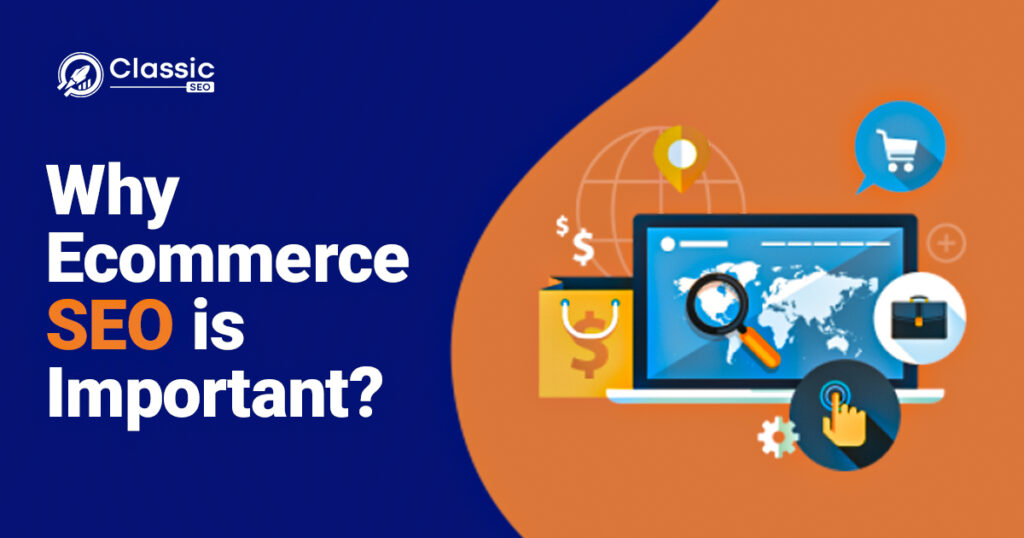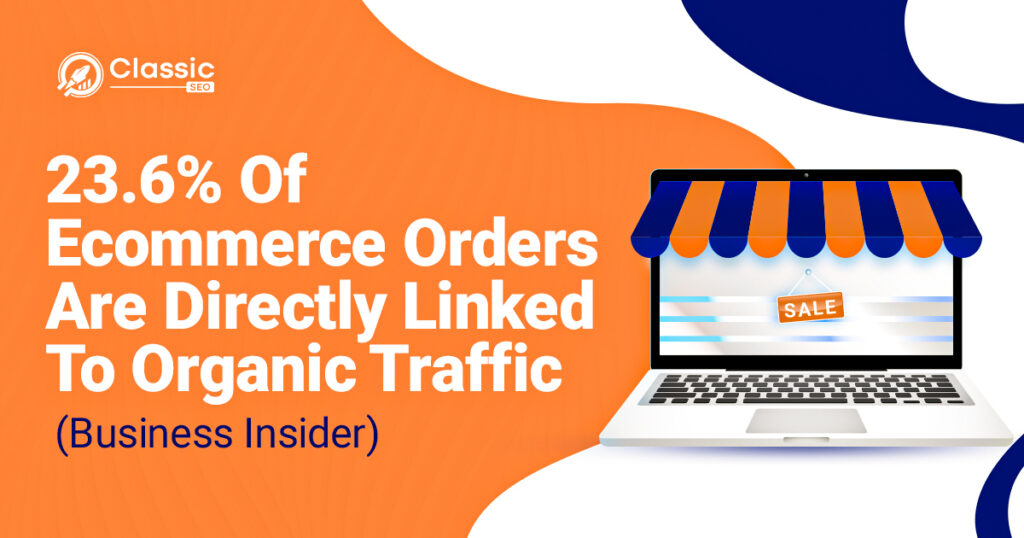Many e-stores rely exclusively on paid marketing campaigns to improve their online presence and, consequently, their sales. But tell you what, there’s a better, more cost-effective option: e-commerce SEO. Paid marketing campaigns and SEO can be implemented side-by-side for better cost management and to improve any business’s bottom-line by tenfold.
Let’s look into what e-commerce SEO is before diving into 8 time-tested, extremely helpful tips that can improve traffic to your e-store, bringing in more leads, thus potentially increasing your revenue.
What is e-Commerce SEO?
Every e-commerce business owner/manager wants their website to appear on top of the Search Engine Result Page (SERP) whenever people search for a product relevant to their business. This is because everyone acknowledges organically that the top search engine results get the most click-throughs. For websites to make it to the top-ranked results on Google and other search engines, marketers use a process known as e-commerce SEO.
E-commerce SEO refers to the practice of boosting your e-store ranking on the Search Engine Result Page (SERP) by following guidelines recommended by search engines.
Why is e-Commerce SEO Important?

E-Commerce SEO is a cost-effective, long-term fix if businesses want to gain online visibility and attract sales-qualified and marketing-qualified leads (SQL and MQL). It brings leads without businesses having to reach out to them. Improved visibility means increased brand awareness and, consequently, an increased market authority.
SEO for e-Commerce is significant for understanding the user intent and targeting the right audience. On the other hand, the one loophole in paid marketing is that businesses do not always get the right traffic, which is a loss to the retailer. Not only this, but the ad-blinders can also potentially limit the reach of an e-commerce store’s ads. Therefore, the organic way, i.e., SEO for an e-commerce website, is the goldmine of all times!
5 Reasons Organic Traffic (SEO) is Vital for Your Business

Every business profits tremendously from organic traffic—and driving organic traffic is what SEO does the best. So, look at these five ways any e-commerce business can benefit from SEO and organic traffic.
Gain Qualified Leads
SEO brings more qualified leads, and it’s no science to understand how. The higher a website ranks on SERP, the more visible the brand is to people with purchase intent; the more users will click, the more conversions will happen. Moreover, it’s also possible to utilize local SEO for an e-commerce store to bring traffic from a targeted vicinity. Local SEO is a very effective medium of awareness for e-commerce businesses in a local area.
Boost Conversation Rate
Expert SEO companies combine Search Engine Optimization (SEO) with Conversion Rate Optimization (CRO) to produce a stellar conversion rate for e-commerce products. Conversion rate is defined as the number of visitors on a website that takes the desired action (a conversion) out of the total number of visitors. An example of conversion is making a purchase.
The conversion rate increases with SEO because organic traffic converts at a higher rate than traffic coming from outbound adverts like social media ads. Why? Because ranking organically gives an impression of being trustworthy.
A Cost-Effective Solution
Businesses succeed when they intelligently map out all the solutions for their marketing. SEO integration into your digital marketing plan can help optimize cost management and save paid marketing campaigns from depleting excessive resources.
According to some studies, SEO and other inbound strategies cost 61% less in lead generation than outbound strategies (cold calls, blogging, social media management, emails, etc). That’s a huge difference when discussing Return on Investment (ROI).
Brand Building
Search engine optimization is mostly associated with the generation of organic traffic, but on top of that, it also strengthens an e-commerce store’s branding and brand awareness. Google’s first page increases a brand’s visibility, authority, and engagement. Consequently, its recognition in the market is also increased.
As much as an effective SEO strategy improves brand awareness, brand awareness also strengthens SEO strategy. It helps retain a website’s position on SERP. Well-known brands get more clicks, which is a positive sign for Google’s algorithm.
Get Higher Credibility
Sistrix conducted an extensive analysis with 80 million keywords to determine how users engage with search results. It was concluded that CTR falls sharply right after position one because the first-ranked website is considered the most credible and trustworthy. This is because people know Google keeps on delivering credible data and information to visitors, so it ranks results in order of relevancy. SEO plays a massive role in building that credibility, trustworthiness, and relevance. E-commerce stores can benefit in terms of credibility from the following SEO practices:
- Clear and convincing about pages
- Accurate, relevant, and up-to-date content
- Inbound links
8 Best SEO Ecommerce Tips to Boost Traffic

These eight best SEO e-commerce tips are highly effective in improving e-commerce websites’ ranking and traffic.
Advanced Keyword Research
Advanced keyword research takes first place when it comes to boosting your website traffic. It is not simply stacking up piles of keywords and using them. Instead, it requires deep digging to choose the keywords that align with the company’s goal and products, thus, making it highly relevant to the target audience. For advanced keyword research, you can use several free tools such as Google Suggest, Google Trends, Keyword Planner, and much more.
The key extract is that for advanced keyword research strategies, you need to find the keyword intended for your website and also keep a check on the keywords being used by your competitor.
Local Business Listing
Local business listings or local citations refer to online mention of a business’s name, address, and phone number for a local audience. It is an online directory that usually provides a backlink to the business’s website, so people looking for its products can find it. As more people use backlinks to the website, Google reads that the business is a real deal.
This means there’s a high chance of increasing an e-commerce website’s search engine ranking by building out local listings.
These listings can be found in local directories, websites, social media, or blogs. So, to improve a business’s SEO efforts, actively submitting and managing their online listings through local directories and citation tools can help.
Content Optimization
Content optimization is undoubtedly one of the most used terms in SEO. Content is the lifeblood of any website, whether it is e-commerce based or not. E-commerce websites must optimize the content on the website using content optimization strategies. These strategies include writing user-friendly content that is readable, optimized, and synthesized under proper headings (H1, H2, H3, H4). Adding title tags, meta descriptions, and meta keywords is a crucial aspect of content optimization that an SEO company can help with.
Optimize Product Pages
A well-optimized product page is incredibly crucial for any e-store. It attracts qualified leads at the bottom of the funnel that converts rapidly. These leads know exactly what they want and enter Google looking for stores that sell them.
It is essential to choose product-focused keywords that prospects probably search for when looking for a product. The keyword should have transactional intent and be relevant—it’s best to narrow down such keywords after extensive keyword research.
The first things a prospect sees on SERP as they search for a product are title tags and meta descriptions. Hence, it is essential to use these keywords there along with the name and model of the product, the brand’s name, and the product’s unique selling point. On the product pages, make sure to incorporate:
- Proper photographs of every product with optimized images·
- Proper internal linking and backlinking
- Direct CTAs to urge users to take action
Make A Mobile Responsive and Friendly Website
According to a study, 66% of all site visits come from mobile devices, which is why Google has switched to mobile-first indexing for every website. This makes it crucial for e-commerce stores and their pages to be optimized for flawless user experience on mobile devices. Some of the things to take care of while optimizing for mobile are:
- Mobile content – make sure all content forms are crawlable and indexable on mobile
- Mobile site performance – use responsive and speedy designs that work well for mobile
- Easy-to-view navigation menu – tailor the mobile navigation experience per user’s likeness and ease
- Remove annoying pop-ups – they may be suitable for the desktop version but might come in the way of the user and the content on mobile.
- Optimize copy for mobile – website copy may not always translate well on mobile, so make sure to shorten it for the mobile version.
Many more SEO-oriented actions can be taken for mobile versions of websites, but these are excellent points to start with.
Get Rid of Broken (404) Errors
Every user experiences the pain of a 404 page at some point in their browsing experience. This type of client error indicates that the page a user tries to reach can not be found on the server. In addition, such pages harm an e-commerce brand by negatively impacting SEO, making it hard for search engines to crawl a site/page. This makes it increasingly essential to fix these errors, but how?
It’s crucial to run routine site audits to identify 404 errors. Having identified them, the process of fixing them can be initiated by an expert.
Maximize Website Speed by Image Optimization
It’s not a good idea to randomly stuff pictures from stock images into a website. Some of them are like giant dumbbells that make sites weighty and slower. This is why some marketers stress a lot about image optimization for e-commerce stores.
Image optimization enhances user experience, decreases page load time, and improves ranking. Some basic steps that can be taken to optimize images include:
- Choosing an appropriate image format (JPEG, PNG, webP)
- Compressing images
- Using compelling images
- Using descriptive files names with keywords
- Using SEO-friendly alt text
- Using mobile-friendly images
Include An XML Site Map for Important Pages
An XML sitemap is a file enlisting all essential pages of a website. This ensures that Google can find and crawl them all. Moreover, it helps it to understand the overall structure of your website.
According to Google, sitemaps are essential for a massive website with extensive archives and websites that use rich media content. Of course, this means it is also necessary for an e-commerce website. So, websites must make sure to add their XML sitemap to the Google Search Console account.
How will SEO Company be Helpful?
One last question that usually sticks at the end of every SEO-related write-up is: is it essential to hire an SEO company for our business’s SEO strategy?
The plain answer is yes. It’s beneficial for an e-commerce store to outsource its SEO. SEO companies are experienced and know new Google updates and premium tools that benefit SEO strategy. Doing SEO on your own, based on experiments and guesswork, can result in your pages being penalized and removed from search engines.

